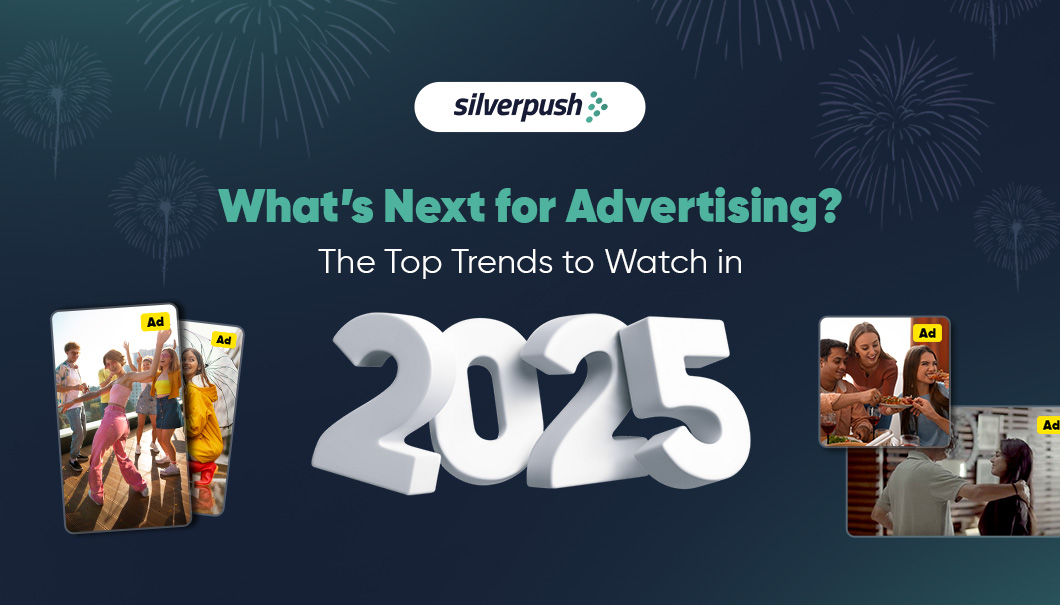Top Advertising Trends You Can’t Miss in 2025 | 12 Dec, 2024

Advertising trends come and go, but some campaigns leave an unforgettable mark. Think about Nike’s 1988 ‘Just Do It’ ad or the memorable ‘Share a Coke’ campaign—what makes them stick? They didn’t just sell a product; they captured the cultural moments and spoke to their audiences in ways that felt personal and relevant.
As we inch closer towards 2025, the ad industry is in for a sea change all over again. With global advertising spending projected to hit $1 trillion in 2024, the stakes for marketers have never been higher. So, let’s dive into the key trends in advertising reshaping strategies, and unlocking opportunities in 2025.
1. The Rise of AI-Powered Advertising
AI is making advertising game-changing from “nice to have” to “have to have.” Searches for “AI advertising” have increased by 557% over the last two years, showing brands are tapping into its immense potential. According to Statista, 80% of digital marketers will integrate some form of AI into their strategies, and AI will form the backbone of modern advertising.
AI-powered tools, like Dynamic Creative Optimisation (DCO), let you create ads in real time that warm up audiences when a cold snap hits. Predictive analytics, which enables brands to anticipate consumer needs even before they do.
Platforms like Netflix and Amazon have perfected this, using AI to recommend shows or products that align with your preferences. Success stories like RedBalloon, which tested thousands of ad variations daily, show how AI can drive seriously impressive results, including a return on ad spend of 1,100%.
Beyond increasing performance, AI saves time and refines targeting while even creating ideas. And if you haven’t leaped into the pool yet, now’s the time; AI is not just the future of advertising—it’s the present.
2. Short-Form Video Content: The New King of Engagement
Gone are the days when consumers would patiently sit through long, drawn-out ads. TikTok, Instagram Reels, and YouTube Shorts have ushered in a new era of bite-sized, high-impact content to stay.
For example, a study revealed that 36% of marketers are of the view that short-form videos drive the highest ROI. Why? Because these videos hook instant attention and convey a message in under a minute-perfect for today’s on-the-go audience.
Storytelling is the success mantra for your brand. Be it a funny skit, an emotional tale, or a bold call to action, the short-form videos just need to leave a mark. Remember, visuals are as important as the message. Optimize for mobile-first, vertical viewing, and use captions to keep your story accessible even when viewed on mute.
In 2025, short-form content isn’t just a trend; it’s a must-have for modern advertising. Scroll-stopping videos are now the driving force behind campaigns that engage audiences and deliver measurable results.
3. Authenticity in Social Media Advertising
Social media has made it crystal clear that consumers are craving authenticity. Flashy, overpolished campaigns simply won’t cut it because modern audiences want to see the real, raw, and relatable side of your brand.
Research proves that 39% of consumers value authenticity most when learning about a brand, hence the importance of partnering with influencers that align with your brand ethos, especially micro, and nano-influencers with highly engaged audiences when building trust and loyalty.
Another powerful tool in your armory is user-generated content. Whether it’s a glowing review, an unboxing video, or customers using your product, UGC adds a level of credibility that traditional ads often can’t match.
4. Privacy-First Advertising: A Necessity, Not a Trend
In 2025, consumer privacy will be at the forefront of advertising strategies. With regulations such as GDPR and CCPA already setting the pace for how brands should handle consumer data, it’s crystal clear that privacy is no longer a buzzword but a necessity.
The phasing out of third-party cookies is pushing brands to change their approach towards targeting. The rapidly rising contextual targeting, where advertisements are served based on viewed content and not browsing history, is becoming the alternative go-to solution. It’s a privacy-friendly way to serve relevant ads that resonate.
Moreover, first-party data—gathered directly from your audience—is becoming increasingly valuable. By fostering trust and encouraging consumers to share preferences willingly, you can craft personalized, privacy-compliant campaigns that drive results.
The key takeaway? In 2025, trust will be your brand’s most valuable asset. Transparent data practices won’t just help you comply with regulations—they’ll help you build stronger, more meaningful connections with your audience.
5. Programmatic Advertising: Smarter, Faster, and Growing
With privacy-first strategies redefining the use of data, programmatic advertising is revolutionizing how brands connect with audiences. By automating ad buying, marketers can serve the right message to the right person at the perfect moment, driving real results with precision.
In 2025, the programmatic technology will be even more sophisticated. Features like predictive analytics will let brands predict consumer behavior and optimize ad spending for maximum ROI. Meanwhile, programmatic continues to grow into new channels, including connected TV and mobile, opening up a whole new world of possibility in deeper engagement.
A programmatic boom will hit emerging markets, too. With improving internet access and digital adoption across Asia, Africa, and Latin America, advertisers increasingly apply more programmatic strategies to reach target audiences in the areas. Improved infrastructure combined with a more digitally literate population ought to drive a spike in the use of programmatic display ads, unlocking new opportunities for brands that need scale and growth.
Final Thoughts
In 2025, the digital advertising market is evolving rapidly and opening up challenges and opportunities alike. From leveraging AI to predict consumer behavior to crafting emotionally resonant stories, the latest advertising trends are all about forging meaningful connections with audiences.
To stay ahead, brands have to move with innovation and adopt strategies that balance the latest technology with trust. For example, brands like Netflix are already using AI-driven insights to deliver hyper-personalized recommendations, while platforms like TikTok drive engagement with authentic, user-generated content.
So, what’s next? Discover the top advertising trends for 2025 and create a future-proof strategy that will make your brand stand out in a fast-changing market.

BLOGS
Partner Spotlight: Alice Ovadia, VP of Media Strategy
Silverpush is excited to highlight TRUth for our Partner Spotlight this week. We caught up with Alice Ovadia, VP of Media Strategy at TRUth, to learn more about the agency and talked to her about her big predictions for the ad market in the coming years. Here’s what Alice said. 1. ...

BLOGS
Why Granular Insights Are Critical for Ad Campaign Optimization
When your ad campaign ends and the dashboard lights up with a “great” VTR or a CTR that’s above average, you celebrate, right? But then comes the pause. What actually made it work? Was it the creative? The audience? The time of day? The context of the video? Most platforms ...

BLOGS
YouTube CTV Advertising: Bigger Screens, Bigger Impact
YouTube has always been a powerhouse for brands looking to connect with audiences. With over 2 billion monthly active users, it’s a platform that reaches people everywhere, on their phones, tablets, and laptops. However, the way people watch YouTube today is very different from how it used to be in the ...







